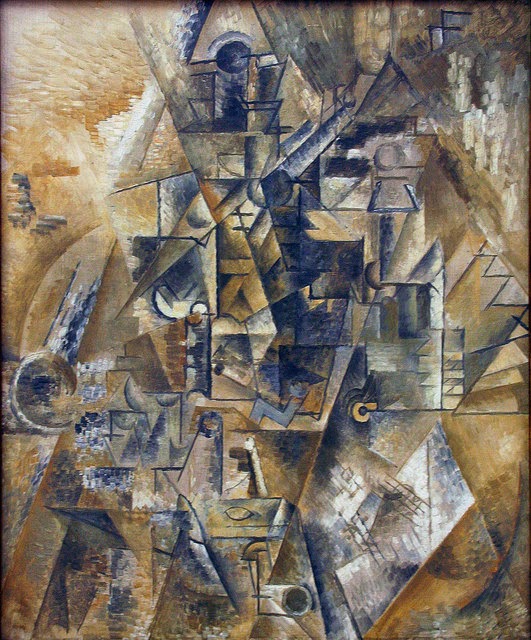%2C_oil_on_canvas%2C_exhibited_at_Centre_for_Modern_and_Contemporary_Art%2C_Veletrzni_(Trades_Fair)_Palace%2C_Prague.jpg) |
| Pablo Picasso, 1911, Klarinet (Stilleven met een klarinet op een tafel) [klik om te vergroten] |
Op m’n zestiende wilde ik een klarinet. Het waren de sterren van de jazzmuziek die voor mij een belofte inhielden: Sidney Bechet (‘Petite Fleur’), Benny Goodman. Maar op de Nijmeegse muziekschool leefden ze nog in de 18e, 19e eeuw, met Fritz Kröpsch en Carl Stamitz (‘Klarinettenkonzert B-dur’). Helaas kon ik daarna ook bij Jan de Pijper, een begaafd muzikant van wie ik later in Amsterdam les had, mijn draai niet meer vinden.
Zo raakte ik, ondanks de ‘vrije’ setting, in een spagaat tussen eigen interesse en de eis van de les. Maar ik stak er wel íets van op, en het instrument bleef me boeien. Wel had ik broertje dood aan spelen van papier.
Ik ben pas echt klarinet gaan spelen toen ik begon te improviseren. Niet in bepaalde stijl, en zonder grondmelodie. It was just me.In het – enige – belendende vertrek van onze woonboot luisterde Klaaske mee. Ze vond het fijn om er naar te luisteren, ondanks de hartenkreten die het instrument soms slaakte. Zo speelde ik jaren op m’n eentje, maar altijd ook een beetje voor haar.
Mijn solospel was, denk ik, een manier om mezelf te horen – en een beetje gehoord te worden – waar woorden bleven steken of tekort schoten. Maar uiteindelijk bleek het geen taal waarmee ik buiten mijn eigen wereld kon treden. Op m’n vijftigste heb ik de klarinet in de wilgen gehangen.
De adembenemende beelden laten de techniek tot in het kleinste detail zien.
“Improvisation is flying. You have to take off gradually as far as your mind can take you. It depends on your mental and physical state , and if you are playing for an audience their reactions and expectations play an important role. It is an emotional transaction. If the audience wants you higher, they send you higher and vice versa.
Improvisation is painting. You start with a blank canvas with no idea what you want to create on it, the subject is unknown. You have the instruments, which are the color and the brush, and your mind and imagination sets the limits of how far you can go. Its a work which take place at a particular moment, never recreated.
Finally, it is the power of musicianship, technique, style and experience which over-shadows the finished work to the extent that it becomes identified as the artist’ own.”
Kayhan Kalhor
Uit: As Night Falls on the Silk Road, Persian and Indian Improvisations.
“The music that we play together reflects the improvisatory styles of our cultures. This means taking a small idea or melodic phrase and developing it in something larger, beyond its primary character. That is the most important aspect of this music. It is taking an idea and than moving it a step further and then further, bringing each other along without crossing each others’ boundaries.”
Kayhan Kalhor
